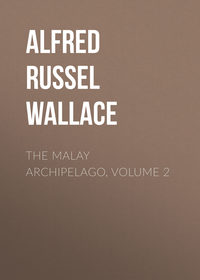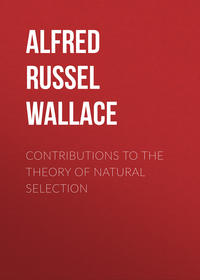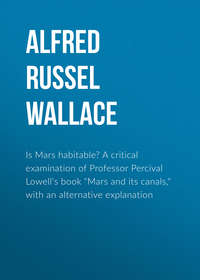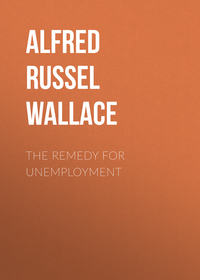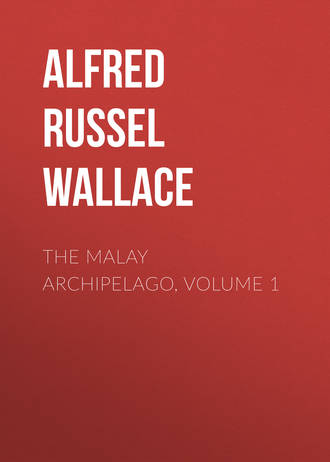 полная версия
полная версияThe Malay Archipelago, Volume 1
Taking it as a whole, and surveying it from every point of view, Java is probably the very finest and most interesting tropical island in the world. It is not first in size, but it is more than 600 miles long, and from 60 to 120 miles wide, and in area is nearly equal to England; and it is undoubtedly the most fertile, the most productive, and the most populous island within the tropics. Its whole surface is magnificently varied with mountain and forest scenery. It possesses thirty-eight volcanic mountains, several of which rise to ten or twelve thousand feet high. Some of these are in constant activity, and one or other of them displays almost every phenomenon produced by the action of subterranean fires, except regular lava streams, which never occur in Java. The abundant moisture and tropical heat of the climate causes these mountains to be clothed with luxuriant vegetation, often to their very summits, while forests and plantations cover their lower slopes. The animal productions, especially the birds and insects, are beautiful and varied, and present many peculiar forms found nowhere else upon the globe.
The soil throughout the island is exceedingly fertile, and all the productions of the tropics, together with many of the temperate zones, can be easily cultivated. Java too possesses a civilization, a history and antiquities of its own, of great interest. The Brahminical religion flourished in it from an epoch of unknown antiquity until about the year 1478, when that of Mahomet superseded it. The former religion was accompanied by a civilization which has not been equalled by the conquerors; for, scattered through the country, especially in the eastern part of it, are found buried in lofty forests, temples, tombs, and statues of great beauty and grandeur; and the remains of extensive cities, where the tiger, the rhinoceros, and the wild bull now roam undisturbed. A modern civilization of another type is now spreading over the land. Good roads run through the country from end to end; European and native rulers work harmoniously together; and life and property are as well secured as in the best governed states of Europe. I believe, therefore, that Java may fairly claim to be the finest tropical island in the world, and equally interesting to the tourist seeking after new and beautiful scenes; to the naturalist who desires to examine the variety and beauty of tropical nature; or to the moralist and the politician who want to solve the problem of how man may be best governed under new and varied conditions.
The Dutch mail steamer brought me from Ternate to Sourabaya, the chief town and port in the eastern part of Java, and after a fortnight spent in packing up and sending off my last collections, I started on a short journey into the interior. Travelling in Java is very luxurious but very expensive, the only way being to hire or borrow a carriage, and then pay half a crown a mile for post-horses, which are changed at regular posts every six miles, and will carry you at the rate of ten miles an hour from one end of the island to the other. Bullock carts or coolies are required to carry all extra baggage. As this kind of travelling would not suit my means, I determined on making only a short journey to the district at the foot of Mount Arjuna, where I was told there were extensive forests, and where I hoped to be able to make some good collections. The country for many miles behind Sourabaya is perfectly flat and everywhere cultivated; being a delta or alluvial plain, watered by many branching streams. Immediately around the town the evident signs of wealth and of an industrious population were very pleasing; but as we went on, the constant succession of open fields skirted by rows of bamboos, with here and there the white buildings and a tall chimney of a sugar-mill, became monotonous. The roads run in straight lines for several miles at a stretch, and are bordered by rows of dusty tamarind-trees. At each mile there are little guardhouses, where a policeman is stationed; and there is a wooden gong, which by means of concerted signals may be made to convey information over the country with great rapidity. About every six or seven miles is the post-house, where the horses are changed as quickly as were those of the mail in the old coaching days in England.
I stopped at Modjo-kerto, a small town about forty miles south of Sourabaya, and the nearest point on the high road to the district I wished to visit. I had a letter of introduction to Mr. Ball, an Englishman, long resident in Java and married to a Dutch lady; and he kindly invited me to stay with him until I could fix on a place to suit me. A Dutch Assistant Resident as well as a Regent or native Javanese prince lived here. The town was neat, and had a nice open grassy space like a village green, on which stood a magnificent fig-tree (allied to the Banyan of India, but more lofty), under whose shade a kind of market is continually held, and where the inhabitants meet together to lounge and chat. The day after my arrival, Mr. Ball drove me over to the village of Modjo-agong, where he was building a house and premises for the tobacco trade, which is carried on here by a system of native cultivation and advance purchase, somewhat similar to the indigo trade in British India. On our way we stayed to look at a fragment of the ruins of the ancient city of Modjo-pahit, consisting of two lofty brick masses, apparently the sides of a gateway. The extreme perfection and beauty of the brickwork astonished me. The bricks are exceedingly fine and hard, with sharp angles and true surfaces. They are laid with great exactness, without visible mortar or cement, yet somehow fastened together so that the joints are hardly perceptible, and sometimes the two surfaces coalesce in a most incomprehensible manner.
Such admirable brickwork I have never seen before or since. There was no sculpture here, but an abundance of bold projections and finely-worked mouldings. Traces of buildings exist for many miles in every direction, and almost every road and pathway shows a foundation of brickwork beneath it—the paved roads of the old city. In the house of the Waidono or district chief at Modjo-agong, I saw a beautiful figure carved in high relief out of a block of lava, and which had been found buried in the ground near the village. On my expressing a wish to obtain some such specimen, Mr. B. asked the chief for it, and much to my surprise he immediately gave it me. It represented the Hindu goddess Durga, called in Java, Lora Jong-grang (the exalted virgin). She has eight arms, and stands on the back of a kneeling bull. Her lower right hand holds the tail of the bull, while the corresponding left hand grasps the hair of a captive, Dewth Mahikusor, the personification of vice, who has attempted to slay her bull. He has a cord round his waist, and crouches at her feet in an attitude of supplication. The other hands of the goddess hold, on her right side, a double hook or small anchor, a broad straight sword, and a noose of thick cord; on her left, a girdle or armlet of large beads or shells, an unstrung bow, and a standard or war flag. This deity was a special favourite among the old Javanese, and her image is often found in the ruined temples which abound in the eastern part of the island.
The specimen I had obtained was a small one, about two feet high, weighing perhaps a hundredweight; and the next day we had it conveyed to Modjo-Kerto to await my return to Sourabaya. Having decided to stay some time at Wonosalem, on the lower slopes of the Arjuna Mountain, where I was informed I should find forest and plenty of game, I had first to obtain a recommendation from the Assistant Resident to the Regent, and then an order from the Regent to the Waidono; and when after a week's delay I arrived with my baggage and men at Modjo-agong, I found them all in the midst of a five days' feast, to celebrate the circumcision of the Waidono's younger brother and cousin, and had a small room in an on outhouse given me to stay in. The courtyard and the great open reception-shed were full of natives coming and going and making preparations for a feast which was to take place at midnight, to which I was invited, but preferred going to bed. A native band, or Gamelang, was playing almost all the evening, and I had a good opportunity of seeing the instruments and musicians. The former are chiefly gongs of various sizes, arranged in sets of from eight to twelve, on low wooden frames. Each set is played by one performer with one or two drumsticks. There are also some very large gongs, played singly or in pairs, and taking the place of our drums and kettledrums. Other instruments are formed by broad metallic bars, supported on strings stretched across frames; and others again of strips of bamboo similarly placed and producing the highest notes. Besides these there were a flute and a curious two-stringed violin, requiring in all twenty-four performers. There was a conductor, who led off and regulated the time, and each performer took his part, coming in occasionally with a few bars so as to form a harmonious combination. The pieces played were long and complicated, and some of the players were mere boys, who took their parts with great precision. The general effect was very pleasing, but, owing to the similarity of most of the instruments, more like a gigantic musical box than one of our bands; and in order to enjoy it thoroughly it is necessary to watch the large number of performers who are engaged in it. The next morning, while I was waiting for the men and horses who were to take me and my baggage to my destination, the two lads, who were about fourteen years old, were brought out, clothed in a sarong from the waist downwards, and having the whole body covered with yellow powder, and profusely decked with white blossom in wreaths, necklaces, and armlets, looking at first sight very like savage brides. They were conducted by two priests to a bench placed in front of the house in the open air, and the ceremony of circumcision was then performed before the assembled crowd.
The road to Wonosalem led through a magnificent forest in the depths of which we passed a fine ruin of what appeared to have been a royal tomb or mausoleum. It is formed entirely of stone, and elaborately carved. Near the base is a course of boldly projecting blocks, sculptured in high relief, with a series of scenes which are probably incidents in the life of the defunct. These are all beautifully executed, some of the figures of animals in particular, being easily recognisable and very accurate. The general design, as far as the ruined state of the upper part will permit of its being seen, is very good, effect being given by an immense number and variety of projecting or retreating courses of squared stones in place of mouldings. The size of this structure is about thirty feet square by twenty high, and as the traveller comes suddenly upon it on a small elevation by the roadside, overshadowed by gigantic trees, overrun with plants and creepers, and closely backed by the gloomy forest, he is struck by the solemnity and picturesque beauty of the scene, and is led to ponder on the strange law of progress, which looks so like retrogression, and which in so many distant parts of the world has exterminated or driven out a highly artistic and constructive race, to make room for one which, as far as we can judge, is very far its inferior.
Few Englishmen are aware of the number and beauty of the architectural remains in Java. They have never been popularly illustrated or described, and it will therefore take most persons by surprise to learn that they far surpass those of Central America, perhaps even those of India. To give some idea of these ruins, and perchance to excite wealthy amateurs to explore them thoroughly and obtain by photography an accurate record of their beautiful sculptures before it is too late, I will enumerate the most important, as briefly described in Sir Stamford Raffles' "History of Java."
BRAMBANAM.—Near the centre of Java, between the native capitals of Djoko-kerta and Surakerta, is the village of Brambanam, near which are abundance of ruins, the most important being the temples of Loro-Jongran and Chandi Sewa. At Loro-Jongran there were twenty separate buildings, six large and fourteen small temples. They are now a mass of ruins, but the largest temples are supposed to have been ninety feet high. They were all constructed of solid stone, everywhere decorated with carvings and bas-reliefs, and adorned with numbers of statues, many of which still remain entire. At Chandi Sewa, or the "Thousand Temples," are many fine colossal figures. Captain Baker, who surveyed these ruins, said he had never in his life seen "such stupendous and finished specimens of human labour, and of the science and taste of ages long since forgot, crowded together in so small a compass as in this spot." They cover a space of nearly six hundred feet square, and consist of an outer row of eighty-four small temples, a second row of seventy-six, a third of sixty-four, a fourth of forty-four, and the fifth forming an inner parallelogram of twenty-eight, in all two hundred and ninety-six small temples; disposed in five regular parallelograms. In the centre is a large cruciform temple surrounded by lofty flights of steps richly ornamented with sculpture, and containing many apartments. The tropical vegetation has ruined most of the smaller temples, but some remain tolerably perfect, from which the effect of the whole may be imagined.
About half a mile off is another temple, called Chandi Kali Bening, seventy-two feet square and sixty feet high, in very fine preservation, and covered with sculptures of Hindu mythology surpassing any that exist in India, other ruins of palaces, halls, and temples, with abundance of sculptured deities, are found in the same neighbourhood.
BOROBODO.—About eighty miles westward, in the province of Kedu, is the great temple of Borobodo. It is built upon a small hill, and consists of a central dome and seven ranges of terraced walls covering the slope of the hill and forming open galleries each below the other, and communicating by steps and gateways. The central dome is fifty feet in diameter; around it is a triple circle of seventy-two towers, and the whole building is six hundred and twenty feet square, and about one hundred feet high. In the terrace walls are niches containing cross-legged figures larger than life to the number of about four hundred, and both sides of all the terrace walls are covered with bas-reliefs crowded with figures, and carved in hard stone and which must therefore occupy an extent of nearly three miles in length! The amount of human labour and skill expended on the Great Pyramid of Egypt sinks into insignificance when compared with that required to complete this sculptured hill-temple in the interior of Java.
GUNONG PRAU.—About forty miles southwest of Samarang, on a mountain called Gunong Prau, an extensive plateau is covered with ruins. To reach these temples, four flights of stone steps were made up the mountain from opposite directions, each flight consisting of more than a thousand steps. Traces of nearly four hundred temples have been found here, and many (perhaps all) were decorated with rich and delicate sculptures. The whole country between this and Brambanam, a distance of sixty miles, abounds with ruins, so that fine sculptured images may be seen lying in the ditches, or built into the walls of enclosures.
In the eastern part of Java, at Kediri and in Malang, there are equally abundant traces of antiquity, but the buildings themselves have been mostly destroyed. Sculptured figures, however, abound; and the ruins of forts, palaces, baths, aqueducts, and temples, can be everywhere traced. It is altogether contrary to the plan of this book to describe what I have not myself seen; but, having been led to mention them, I felt bound to do something to call attention to these marvellous works of art. One is overwhelmed by the contemplation of these innumerable sculptures, worked with delicacy and artistic feeling in a hard, intractable, trachytic rock, and all found in one tropical island. What could have been the state of society, what the amount of population, what the means of subsistence which rendered such gigantic works possible, will, perhaps, ever remain a mystery; and it is a wonderful example of the power of religious ideas in social life, that in the very country where, five hundred years ago, these grand works were being yearly executed, the inhabitants now only build rude houses of bamboo and thatch, and look upon these relics of their forefathers with ignorant amazement, as the undoubted productions of giants or of demons. It is much to be regretted that the Dutch Government does not take vigorous steps for the preservation of these ruins from the destroying agency of tropical vegetation; and for the collection of the fine sculptures which are everywhere scattered over the land.
Wonosalem is situated about a thousand feet above the sea, but unfortunately it is at a distance from the forest, and is surrounded by coffee plantations, thickets of bamboo, and coarse grasses. It was too far to walk back daily to the forest, and in other directions I could find no collecting ground for insects. The place was, however, famous for peacocks, and my boy soon shot several of these magnificent birds, whose flesh we found to be tender, white, and delicate, and similar to that of a turkey. The Java peacock is a different species from that of India, the neck being covered with scale-like green feathers, and the crest of a different form; but the eyed train is equally large and equally beautiful. It is a singular fact in geographical distribution that the peacock should not be found in Sumatra or Borneo, while the superb Argus, Fire-backed and Ocellated pheasants of those islands are equally unknown in Java. Exactly parallel is the fact that in Ceylon and Southern India, where the peacock abounds, there are none of the splendid Lophophori and other gorgeous pheasants which inhabit Northern India. It would seem as if the peacock can admit of no rivals in its domain. Were these birds rare in their native country, and unknown alive in Europe, they would assuredly be considered as the true princes of the feathered tribes, and altogether unrivalled for stateliness and beauty. As it is, I suppose scarcely anyone if asked to fix upon the most beautiful bird in the world would name the peacock, any more than the Papuan savage or the Bugis trader would fix upon the bird of paradise for the same honour.
Three days after my arrival at Wonosalem, my friend Mr. Ball came to pay me a visit. He told me that two evenings before, a boy had been killed and eaten by a tiger close to Modjo-agong. He was riding on a cart drawn by bullocks, and was coming home about dusk on the main road; and when not half a mile from the village a tiger sprang upon him, carried him off into the jungle close by, and devoured him. Next morning his remains were discovered, consisting only of a few mangled bones. The Waidono had got together about seven hundred men, and were in chase of the animal, which, I afterwards heard, they found and killed. They only use spears when in pursuit of a tiger in this way. They surround a large tract of country, and draw gradually together until the animal is enclosed in a compact ring of armed men. When he sees there is no escape he generally makes a spring, and is received on a dozen spears, and almost instantly stabbed to death. The skin of an animal thus killed is, of course, worthless, and in this case the skull, which I had begged Mr. Ball to secure for me, was hacked to pieces to divide the teeth, which are worn as charms.
After a week at Wonosalem, I returned to the foot of the mountain, to a village named Djapannan, which was surrounded by several patches of forest, and seemed altogether pretty well suited to my pursuits. The chief of the village had prepared two small bamboo rooms on one side of his own courtyard to accommodate me, and seemed inclined to assist me as much as he could. The weather was exceedingly hot and dry, no rain having fallen for several months, and there was, in consequence, a great scarcity of insects, and especially of beetles. I therefore devoted myself chiefly to obtaining a good set of the birds, and succeeded in making a tolerable collection. All the peacocks we had hitherto shot had had short or imperfect tails, but I now obtained two magnificent specimens more than seven feet long, one of which I preserved entire, while I kept the train only attached to the tail of two or three others. When this bird is seen feeding on the ground, it appears wonderful how it can rise into the air with such a long and cumbersome train of feathers. It does so however with great ease, by running quickly for a short distance, and then rising obliquely; and will fly over trees of a considerable height. I also obtained here a specimen of the rare green jungle-fowl (Gallus furcatus), whose back and neck are beautifully scaled with bronzy feathers, and whose smooth-edged oval comb is of a violet purple colour, changing to green at the base. It is also remarkable in possessing a single large wattle beneath its throat, brightly coloured in three patches of red, yellow, and blue. The common jungle-cock (Gallus bankiva) was also obtained here. It is almost exactly like a common game-cock, but the voice is different, being much shorter and more abrupt; hence its native name is Bekeko. Six different kinds of woodpeckers and four kingfishers were found here, the fine hornbill, Buceros lunatus, more than four feet long, and the pretty little lorikeet, Loriculus pusillus, scarcely more than as many inches.
One morning, as I was preparing and arranging specimens, I was told there was to be a trial; and presently four or five men came in and squatted down on a mat under the audience-shed in the court. The chief then came in with his clerk, and sat down opposite them. Each spoke in turn, telling his own tale, and then I found that those who first entered were the prisoner, accuser, policemen, and witness, and that the prisoner was indicated solely by having a loose piece of cord twined around his wrists, but not tied. It was a case of robbery, and after the evidence was given, and a few questions had been asked by the chief, the accused said a few words, and then sentence was pronounced, which was a fine. The parties then got up and walked away together, seeming quite friendly; and throughout there was nothing in the manner of any one present indicating passion or ill-feeling—a very good illustration of the Malayan type of character.
In a month's collecting at Wonosalem and Djapannan I accumulated ninety-eight species of birds, but a most miserable lot of insects. I then determined to leave East Java and try the more moist and luxuriant districts at the western extremity of the island. I returned to Sourabaya by water, in a roomy boat which brought myself, servants, and baggage at one-fifth the expense it had cost me to come to Modjo-kerto. The river has been rendered navigable by being carefully banked up, but with the usual effect of rendering the adjacent country liable occasionally to severe floods. An immense traffic passes down this river; and at a lock we passed through, a mile of laden boats were waiting two or three deep, which pass through in their turn six at a time.
A few days afterwards I went by steamer to Batavia, where I stayed about a week at the chief hotel, while I made arrangements for a trip into the interior. The business part of the city is near the harbour, but the hotels and all the residences of the officials and European merchants are in a suburb two miles off, laid out in wide streets and squares so as to cover a great extent of ground. This is very inconvenient for visitors, as the only public conveyances are handsome two-horse carriages, whose lowest charge is five guilders (8s. 4d.) for half a day, so that an hour's business in the morning and a visit in the evening costs 16s. 8d. a day for carriage hire alone.
Batavia agrees very well with Mr. Money's graphic account of it, except that his "clear canals" were all muddy, and his "smooth gravel drives" up to the houses were one and all formed of coarse pebbles, very painful to walk upon, and hardly explained by the fact that in Batavia everybody drives, as it can hardly be supposed that people never walk in their gardens. The Hôtel des Indes was very comfortable, each visitor having a sitting-room and bedroom opening on a verandah, where he can take his morning coffee and afternoon tea. In the centre of the quadrangle is a building containing a number of marble baths always ready for use; and there is an excellent table d'hôte breakfast at ten, and dinner at six, for all which there is a moderate charge per day.




